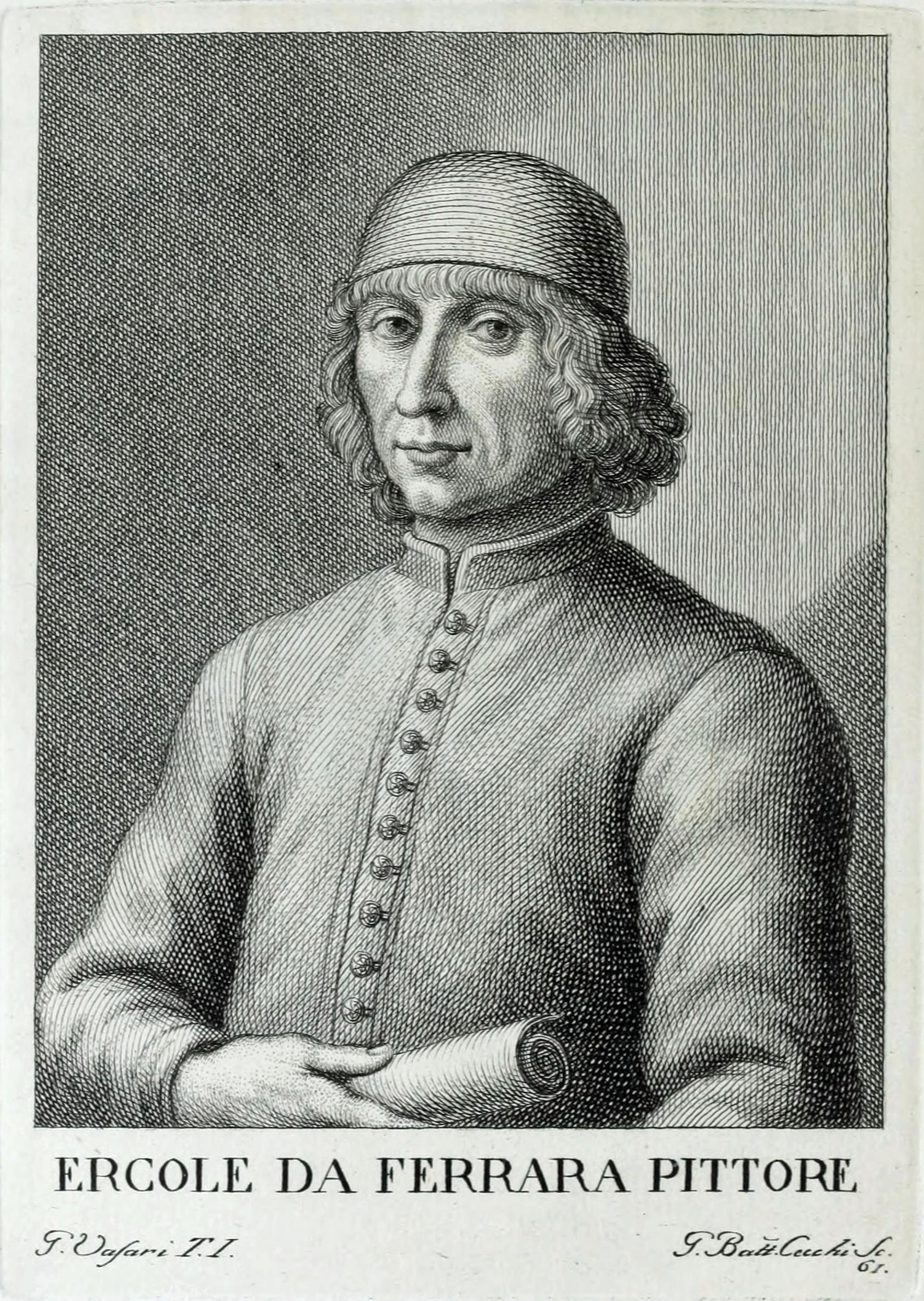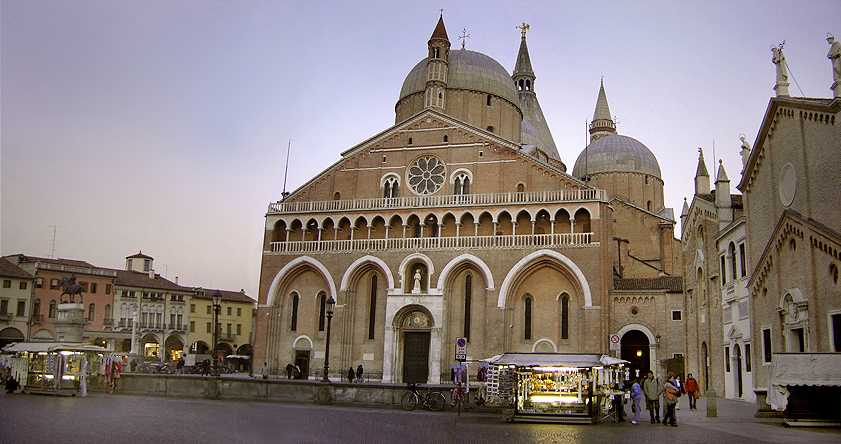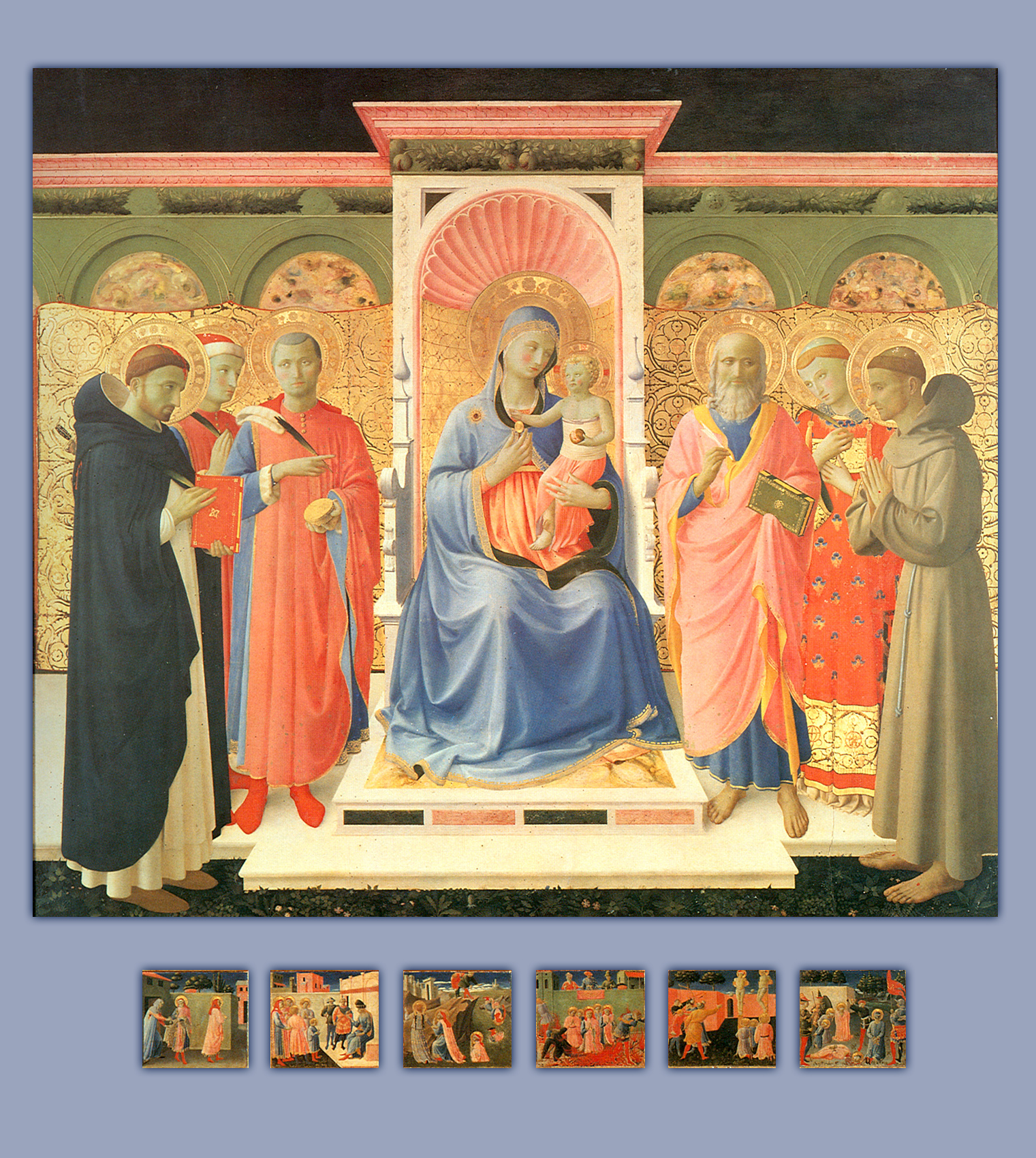|
Santa Maria Di Porto Altarpiece
The ''Santa Maria in Porto Altarpiece'' is a painting by the Italian Renaissance painter Ercole de' Roberti, executed in 1479-1481 and housed in the Pinacoteca di Brera, Milan, northern Italy. It was executed for the church of Santa Maria in Porto, just outside Ravenna. In the 16th century it was moved to the church St. Francis in the same city but, after the Napoleonic invasion of Italy, it was then moved to Milan, being housed at Brera since 1811. Description The painting features a mainly vertical architectural setting, under which a high octagonal podium with the Virgin's throne. The base is decorated by tiles (with the ''Massacre of the Innocents'', ''Adoration of the Magi'' and the ''Presentation in the Temple'') which simulated antique bas-reliefs and were inspired by the altar of the Basilica of Saint Anthony of Padua by Donatello. The base supports columns with mouldings and decorations of garlands, dishes and marble rings, while in the background is a stormy sea. ... [...More Info...] [...Related Items...] OR: [Wikipedia] [Google] [Baidu] |
Ercole De' Roberti
Ercole de' Roberti (c. 1451 – 1496), also known as Ercole Ferrarese or Ercole da Ferrara, was an Italian artist of the Early Renaissance and the School of Ferrara. He was profiled in Vasari's ''Le Vite delle più eccellenti pittori, scultori, ed architettori''. __NOTOC__ The son of the doorkeeper at the Este castle, Ercole later held the position of court artist for the Este family in Ferrara. According to Vasari: Paintings by Ercole are rare. His life was short and many of his works have been destroyed. Works By 1473, Ercole had left Ferrara and was working in Bologna in the studio of Francesco del Cossa. According to Vasari, Ercole also apprenticed under Lorenzo Costa in Bologna, but this seems unlikely as he was Lorenzo's senior by several years. Vasari was likely confusing him with Ercole da Bologna or Ercole Banci. Ercole's first mature works are his contributions to the Griffoni Chapel for the San Petronio Basilica in Bologna: a predella depicting the '' Mira ... [...More Info...] [...Related Items...] OR: [Wikipedia] [Google] [Baidu] |
Pinacoteca Di Brera
The Pinacoteca di Brera ("Brera Art Gallery") is the main public gallery for paintings in Milan, Italy. It contains one of the foremost collections of Italian paintings from the 13th to the 20th century, an outgrowth of the cultural program of the Brera Academy, which shares the site in the Palazzo Brera. History The Palazzo Brera owes its name to the Germanic ''braida'', indicating a grassy opening in the city structure: compare the ''Bra'' of Verona. The convent on the site passed to the Jesuits (1572), then underwent a radical rebuilding by Francesco Maria Richini (1627–28). When the Jesuits were disbanded in 1773, the palazzo remained the seat of the astronomical Observatory and the Braidense National Library founded by the Jesuits. In 1774 the herbarium of the new botanical garden was added. The buildings were extended to designs by Giuseppe Piermarini, who was appointed professor in the Academy when it was formally founded in 1776, with Giuseppe Parini as dean. Pier ... [...More Info...] [...Related Items...] OR: [Wikipedia] [Google] [Baidu] |
Milan
Milan ( , , Lombard: ; it, Milano ) is a city in northern Italy, capital of Lombardy, and the second-most populous city proper in Italy after Rome. The city proper has a population of about 1.4 million, while its metropolitan city has 3.26 million inhabitants. Its continuously built-up urban area (whose outer suburbs extend well beyond the boundaries of the administrative metropolitan city and even stretch into the nearby country of Switzerland) is the fourth largest in the EU with 5.27 million inhabitants. According to national sources, the population within the wider Milan metropolitan area (also known as Greater Milan), is estimated between 8.2 million and 12.5 million making it by far the largest metropolitan area in Italy and one of the largest in the EU.* * * * Milan is considered a leading alpha global city, with strengths in the fields of art, chemicals, commerce, design, education, entertainment, fashion, finance, healthcar ... [...More Info...] [...Related Items...] OR: [Wikipedia] [Google] [Baidu] |
Ravenna
Ravenna ( , , also ; rgn, Ravèna) is the capital city of the Province of Ravenna, in the Emilia-Romagna region of Northern Italy. It was the capital city of the Western Roman Empire from 408 until its collapse in 476. It then served as the capital of the Ostrogothic Kingdom until it was re-conquered in 540 by the Byzantine Empire. Afterwards, the city formed the centre of the Byzantine Exarchate of Ravenna until the last exarch was executed by the Lombards in 751. Although it is an inland city, Ravenna is connected to the Adriatic Sea by the Candiano Canal. It is known for its well-preserved late Roman and Byzantine architecture, with eight buildings comprising the UNESCO World Heritage Site "Early Christian Monuments of Ravenna". History The origin of the name ''Ravenna'' is unclear. Some have speculated that "Ravenna" is related to "Rasenna" (or "Rasna"), the term that the Etruscan civilization, Etruscans used for themselves, but there is no agreement on this point. Ancien ... [...More Info...] [...Related Items...] OR: [Wikipedia] [Google] [Baidu] |
Napoleonic Invasion Of Italy
The Italian campaigns of the French Revolutionary Wars (1792–1802) were a series of conflicts fought principally in Northern Italy between the French Revolutionary Army and a Coalition of Austria, Russia, Piedmont-Sardinia, and a number of other Italian states. The campaign of 1796-1797 brought prominence to Napoleon Bonaparte, a young, largely unknown commander, who led French forces to victory over numerically superior Austrian and Sardinian Armies. First Coalition (1792–1797) The War of the First Coalition broke out in autumn 1792, when several European powers formed an alliance against Republican France. The first major operation was the annexation of the County of Nice and the Duchy of Savoy (both states of the Kingdom of Piedmont-Sardinia) by 30,000 French troops. This was reversed in mid-1793, when the Republican forces were withdrawn to deal with a revolt in Lyon, triggering a counter-invasion of Savoy by the Kingdom of Piedmont-Sardinia (a member of the First Coa ... [...More Info...] [...Related Items...] OR: [Wikipedia] [Google] [Baidu] |
Basilica Of Saint Anthony Of Padua
The Pontifical Basilica of Saint Anthony of Padua ( it, Basilica Pontificia di Sant'Antonio di Padova) is a Catholic church and minor basilica in Padua, Veneto, Northern Italy, dedicated to St. Anthony of Padua. Although the basilica is visited as a place of pilgrimage by people from all over the world, it is not the cathedral of the city, a title belonging to the Cathedral-Basilica of St. Mary of Padua. The basilica is known locally as "il Santo". It is one of the national shrines recognized by the Holy See. History Construction of the Basilica probably began around 1232, just one year after the death of St. Anthony. It was completed in 1310 although several structural modifications (including the falling of the ambulatory and the construction of a new choir screen) took place between the end of the 14th and the mid-15th century. The Saint, according to his will, had been buried in the small church of ''Santa Maria Mater Domini'', probably dating from the late 12th centur ... [...More Info...] [...Related Items...] OR: [Wikipedia] [Google] [Baidu] |
Donatello
Donato di Niccolò di Betto Bardi ( – 13 December 1466), better known as Donatello ( ), was a Republic of Florence, Florentine sculptor of the Renaissance period. Born in Republic of Florence, Florence, he studied classical sculpture and used this to develop a complete Renaissance style in sculpture. He spent time in other cities, and while there he worked on commissions and taught others; his periods in Rome, Padua, and Siena introduced to other parts of Italy his techniques, developed in the course of a long and productive career. Financed by Cosimo de' Medici, Donatello's ''David (Donatello), David'' was the first freestanding Nude (art), nude male sculpture since antiquity. He worked with stone, bronze, wood, clay, stucco, and wax, and had several assistants, with four perhaps being a typical number. Although his best-known works mostly were statues in the round, he developed a new, very shallow, type of bas-relief for small works, and a good deal of his output was large ... [...More Info...] [...Related Items...] OR: [Wikipedia] [Google] [Baidu] |
Antonello Da Messina
Antonello da Messina, properly Antonello di Giovanni di Antonio, but also called Antonello degli Antoni and Anglicized as Anthony of Messina ( 1430February 1479), was an Italian painter from Messina, active during the Early Italian Renaissance. His work shows strong influences from Early Netherlandish painting, although there is no documentary evidence that he ever travelled beyond Italy. Giorgio Vasari credited him with the introduction of oil painting into Italy, although this is now disputed. Unusually for a southern Italian artist of the Renaissance, his work proved influential on painters in northern Italy, especially in Venice. Biography Early life and training Antonello was born at Messina around 1429–1431, to Garita (Margherita) and Giovanni de Antonio Mazonus, a sculptor who trained him early on. He and his family resided in the Sicofanti district of the city. Antonello is thought to have apprenticed in Rome before going to Naples, where Netherlandish painting was ... [...More Info...] [...Related Items...] OR: [Wikipedia] [Google] [Baidu] |
Holy Conversation
In art, a (; plural: ''sacre conversazioni''), meaning holy (or sacred) conversation, is a genre developed in Italian Renaissance painting, with a depiction of the Virgin and Child (the Virgin Mary with the infant Jesus) amidst a group of saints in a relatively informal grouping, as opposed to the more rigid and hierarchical compositions of earlier periods. Donor portraits may also be included, generally kneeling, often their patron saint is presenting them to the Virgin, and angels are frequently in attendance. The term is often used as a title for paintings to avoid listing all the individual figures, although the trend in museums and academic art history is now to give the full list. The name, which only appears as a title retrospectively in the 18th century, has been explained with reference to "their rapt stillness of mood, in which the Saints, scarcely looking at one another, seem to communicate at a spiritual rather than a material level". At least that is the case in ... [...More Info...] [...Related Items...] OR: [Wikipedia] [Google] [Baidu] |
1480s Paintings
148 may refer to: *148 (number), a natural number *AD 148, a year in the 2nd century AD * 148 BC, a year in the 2nd century BC * 148 (album), an album by C418 Daniel Rosenfeld (born 9 May 1989), better known by his stage/online name C418 (pronounced "see four eighteen"), is a German musician, producer and sound engineer, best known as the composer and sound designer for the sandbox video game ''Minec ... * 148 (Meiktila) Battery Royal Artillery * 148 (New Jersey bus) See also * List of highways numbered 148 * {{Number disambiguation ... [...More Info...] [...Related Items...] OR: [Wikipedia] [Google] [Baidu] |
Italian Paintings
Italian(s) may refer to: * Anything of, from, or related to the people of Italy over the centuries ** Italians, an ethnic group or simply a citizen of the Italian Republic or Italian Kingdom ** Italian language, a Romance language *** Regional Italian, regional variants of the Italian language ** Languages of Italy, languages and dialects spoken in Italy ** Italian culture, cultural features of Italy ** Italian cuisine, traditional foods ** Folklore of Italy, the folklore and urban legends of Italy ** Mythology of Italy, traditional religion and beliefs Other uses * Italian dressing, a vinaigrette-type salad dressing or marinade * Italian or Italian-A, alternative names for the Ping-Pong virus, an extinct computer virus See also * * * Italia (other) * Italic (other) * Italo (other) * The Italian (other) * Italian people (other) Italian people may refer to: * in terms of ethnicity: all ethnic Italians, in and outside of Italy * ... [...More Info...] [...Related Items...] OR: [Wikipedia] [Google] [Baidu] |
Paintings In The Pinacoteca Di Brera
Painting is the practice of applying paint, pigment, color or other medium to a solid surface (called the "matrix" or "support"). The medium is commonly applied to the base with a brush, but other implements, such as knives, sponges, and airbrushes, can be used. In art, the term ''painting ''describes both the act and the result of the action (the final work is called "a painting"). The support for paintings includes such surfaces as walls, paper, canvas, wood, glass, lacquer, pottery, leaf, copper and concrete, and the painting may incorporate multiple other materials, including sand, clay, paper, plaster, gold leaf, and even whole objects. Painting is an important form in the visual arts, bringing in elements such as drawing, Composition (visual arts), composition, gesture (as in gestural painting), narrative, narration (as in narrative art), and abstraction (as in abstract art). Paintings can be naturalistic and representational (as in still life and landscape art, lands ... [...More Info...] [...Related Items...] OR: [Wikipedia] [Google] [Baidu] |



.png)





